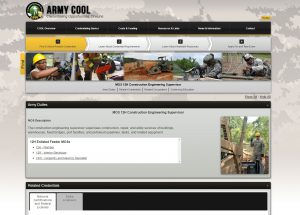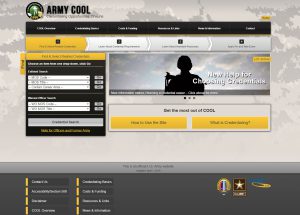Project Description
Feasibility Assessment of Developing a Web-Based Career Guidance Tool for Transitioning Military Personnel
Client
- Civilian occupational classification structure (e.g., O*NET and OOH)
- Occupational requirements in the civilian labor force
- Military occupational classification and structure
- Crosswalking military occupational specialties to civilian occupations
- Application of civilian credentialing requirements to military training and experience
- Design and development of a fully functional web-based prototype
Planning
The purpose of the project was to conduct a comprehensive assessment of the feasibility of developing a web-based career guidance tool for transitioning military personnel. Objectives were to determine whether it is feasible to develop a tool that would meet the career guidance needs of three distinct types of transitioning service members:
- Transitioning Specialists – service members who plan to apply for civilian jobs requiring specific occupational skills that are consistent with their military experience;
- Transitioning Generalists – service members who do not have occupational skills that correspond to civilian occupations;
- Career Switchers – service members considering additional education or training in preparation for a new civilian career.
SOLID was the perfect contractor to complete this project since we:
- Have an in-depth familiarity with military and federal occupational classification schemes;
- Have the technical capability to design and develop the CGT prototype and its underlying database.
Research and Analysis
To meet the project objectives, the Project Team carried out a number of activities, including:
- Conducted a comprehensive review of existing web sites similar in nature to the proposed career guidance tool in order to preclude duplication of effort;
- Interviewed program officials and reviewed literature to assess the information needs of each of the three groups of transitioning service members and veterans;
- Conducted an extensive review of potential data sources, for each of the main components of the tool, including extensive research into the DoD military to civilian crosswalk;
- Using three personas – one for each potential user type – developed an interactive web-based prototype that highlighted the overall design, flow, and content areas of the tool as they pertained to each type of user;
- Identified the steps required to develop the tool, from both a content and web development standpoint, and derived a feasible timeline for completing them; and
- Recommended a content updating and technical maintenance plan for the web-based tool.
The feasibility assessment concluded that existing web sites do not meet the specific needs of the target audience, and that it was feasible, using existing and newly acquired data, to develop a career guidance tool that would meet the needs of each type of transitioning service member. The web-based prototype and final Career Guidance Tool feasibility assessment report presented detailed information about how a tool could be developed that would allow users to:
- Enter their military occupational specialty to view a list of related civilian occupations;
- Select a civilian occupation to view a summary table to determine key pieces of information about that occupation, including:
- O*NET descriptions of the occupations;
- Whether credentials (e.g., certifications, licenses, and apprenticeships) are offered or required to meet occupational requirements and links to searchable databases for more information on credentialing requirements;
- Growth rate for the industry (i.e., high, medium, or low) and links to specific Bureau of Labor Statistics data on projected growth rates;
- O*NET Job Zone, which provides a numeric value to indicate the amount of education, training, and experience required for the particular occupation;
- Related federal jobs and links to federal job search sites;
- Median national salary for the occupation and links to median salary levels by state.
- Take an interest assessment to identify civilian occupations that may match individual interests;
- Develop a profile of work skills and activities and find civilian occupations with similar profiles;
- Gain valuable knowledge about career preparation and resources for filling skills gaps; and
- Get help preparing a resume and searching for a job using online resume writers and job banks.
Prime Contractor
Personnel Decisions Research Institutes (PDRI)
650 Third Avenue South
Suite 1350
Minneapolis, MN 55402
Team Roles
SOLID served as a subcontractor to PDRI, but played an equal role in carrying out project activities. SOLID contributed significantly to project planning and implementation and ensuring the quality of deliverables. SOLID took the lead in providing expertise related to the unique needs of transitioning military personnel.
Development
Achieved Results
SOLID achieved the following results:
- Developed a fully functional web prototype that was not originally part of the scope of the feasibility assessment.
- Developed detailed requirements for a comprehensive web-based career guidance tool that can be used for full project implementation upon availability of funding.


